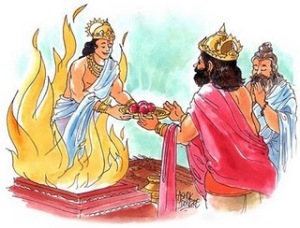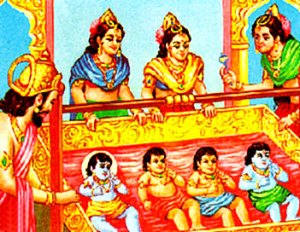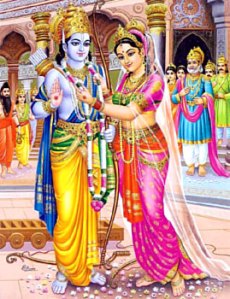 King Dasharatha had three queens: Kausalya, Kaikeyi and Sumitra. As he was heirless, he performed a fire sacrifice known as Putra-Kameshti Yagya. From the sacrificial fire a deity handed to King Dasaratha a vessel of payasam, and instructed him to share it among his three wives so that they could bear him sons.
King Dasharatha had three queens: Kausalya, Kaikeyi and Sumitra. As he was heirless, he performed a fire sacrifice known as Putra-Kameshti Yagya. From the sacrificial fire a deity handed to King Dasaratha a vessel of payasam, and instructed him to share it among his three wives so that they could bear him sons.
At this time the lust-laden Ravana, puffed with pride, was committing terrible atrocities on earth and harassing the gods as well. He had received a boon from Lord Brahma that none could kill him, except man, whom he considered insignificant. When Lord Vishnu, came to know of this, he agreed to incarnate as a human being in order to destroy the wicked, protect the good, and re-establish dharma. Through his inscrutable power of maya, he would be born in the solar dynasty as the son of King Dasaratha.
 Kausalya, the chief queen, gave birth to Sri Rama; Sumitra to the twins Lakshmana and Satrughna; and Kaikeyi to Bharata. Under the watchful eyes of the loving parents and teachers, the boys received various forms of instructions. They became adept in the study of the Vedas, and in the art of warfare and the use of weapons so that they might become the protectors of the society and the kingdom. They were taught the highest moral and ethical values and their character was carefully moulded and developed.
Kausalya, the chief queen, gave birth to Sri Rama; Sumitra to the twins Lakshmana and Satrughna; and Kaikeyi to Bharata. Under the watchful eyes of the loving parents and teachers, the boys received various forms of instructions. They became adept in the study of the Vedas, and in the art of warfare and the use of weapons so that they might become the protectors of the society and the kingdom. They were taught the highest moral and ethical values and their character was carefully moulded and developed.
When Sri Rama was sixteen years old, the Rsi Vishwamitra came to the court of King Dasharatha. He wanted Sri Rama to protect his sacrifice against two marauding demons, Maricha and Subahu. King Dasaratha was at first hesitant to let his son go on such a dangerous excursion but yielded on the advice of Rsi Vasishta. Lakshmana accompanied Sri Rama.
The sage taught Sri Rama and Lakshmana two mystic formulae or mantras known as bal and atibala. These mantras would help them overcome fatigue, hunger and thirst. They also received instructions on the use of mystical weapons.
On the way, they encounter a demoness, Tadaka whom Sri Rama slew with a single arrow.
On last the day of the six-day sacrifice, the two demons attacked. With one arrow, Sri Rama flung Maricha far into the sea. With the other arrow, he slew Subahu.
The Rsi together with the two princes left for Mithila, the capital city of Videha. On the outskirts of the city was a deserted ashrama. It was once the ashrama of Rsi Gautama. His wife Ahalya was so exquisitely beautiful that Lord Indra was filled with an illicit desire for her. He came to Ahalya in the guise of her husband. But the Rsi found out and he cursed them both. Ahalya turned into a stone. It was only when Sri Rama trod on the stone that the curse was removed.
 Janaka was the king of Mithila. Once, as he ploughed the ground during a sacrifice, a female child was found in the furrow. The child was named Sita, the Sanskrit word for furrow. She grew up to be a girl of unparalleled beauty and charm. When Sita was of marriageable age, the king decided to have a swayamvara which included a contest: whoever could wield the bow of Shiva could marry Sita. A host of princes had failed even to move the bow. At the suggestion of the Rsi, Sri Rama effortlessly lifted the bow. As he started to string the bow, it broke with a tremendous crash. Marriages were also arranged between the sons of King Dasharatha and the daughters and nieces of King Janaka.
Janaka was the king of Mithila. Once, as he ploughed the ground during a sacrifice, a female child was found in the furrow. The child was named Sita, the Sanskrit word for furrow. She grew up to be a girl of unparalleled beauty and charm. When Sita was of marriageable age, the king decided to have a swayamvara which included a contest: whoever could wield the bow of Shiva could marry Sita. A host of princes had failed even to move the bow. At the suggestion of the Rsi, Sri Rama effortlessly lifted the bow. As he started to string the bow, it broke with a tremendous crash. Marriages were also arranged between the sons of King Dasharatha and the daughters and nieces of King Janaka.
======================================
